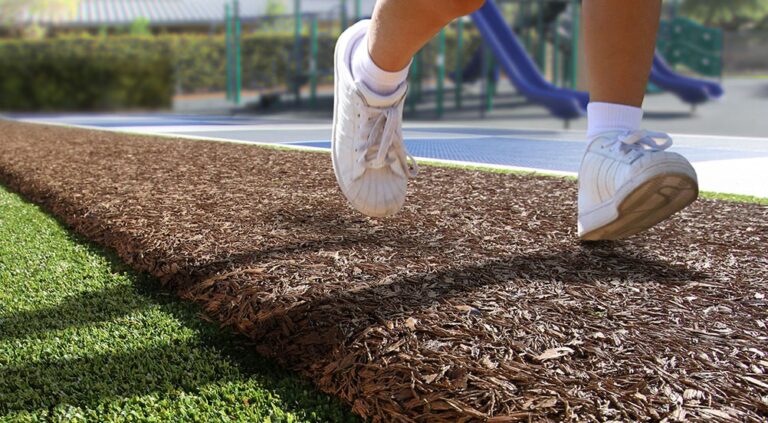Depending on the application, the amount of rubber mulch needed for your project can vary from just a few inches to a minimum of half a foot.
Keep reading to understand how much rubber mulch you need for your project.
How Much Rubber Mulch For Landscaping?
Maintaining an optimal depth of rubber mulch, generally between 1 and 2 inches, is crucial for multiple reasons. Firstly, this thickness forms a robust barrier that effectively inhibits the proliferation of unwanted weeds by blocking sunlight, which is fundamental for their growth. Additionally, a layer within this range helps preserve the soil’s moisture content, an essential factor for the health and vigor of plants within the landscape.
Moreover, ensuring the mulch isn’t too deep is necessary to prevent waterlogging and permit adequate water drainage, keeping the soil’s air-water balance at an ideal level critical for root health. Beyond these practical benefits, a well-maintained mulch depth enhances the aesthetic value of the area. It contributes a polished, cohesive look to the garden or yard, emphasizing the vibrancy of the surrounding plants and creating a visually appealing contrast with the ground.
In order to calculate exactly how much rubber mulch is needed for your project, use our calculator to find the exact amount!

How Much Rubber Mulch For Playgrounds?
The amount of rubber mulch needed for a playground depends on the fall potential present on your playground.
These specifications are designated by the IPEMA.
| Fall Height Protection | Un-compacted Depth | Compacted Depth |
|---|---|---|
| Up to 16 ft. | 7″ | 6″ |
| Up to 12 ft. | 6″ | 7″ |
| Up to 10 ft. | 5″ | 4″ |
Once you’ve determined the depth of mulch needed for your playground, finding the exact amount you need is a simple equation. Simply multiply Depth by Area to find the volume needed!
However, if you don’t want to overcomplicate things, feel free to use our calculator to find out how much rubber mulch you need for your project!
Rubber Mulch FAQ’s
Is Rubber Mulch Better Than Regular Mulch?
“Better” can be subjective and depends on the context in which you’re using the mulch. Here are some comparisons:
- Durability: Rubber mulch doesn’t decompose like regular, organic mulch, so it lasts much longer. This can be seen as an advantage as it doesn’t need to be replaced frequently.
- Soil Health: Regular mulch breaks down over time and adds nutrients to the soil, which can benefit garden plants. Rubber mulch doesn’t offer this benefit.
- Safety: Rubber mulch is often used in playgrounds because it provides good cushioning for falls and doesn’t splinter like wood mulch. However, there are concerns about potential chemical leaching and flammability.
- Pest Control: Rubber mulch is not attractive to termites and other insects that can be drawn to wood mulch. However, it also doesn’t provide the soil-enhancing benefits that attract beneficial earthworms.
How Many Years Does Rubber Mulch Last?
Rubber mulch is quite durable and can last anywhere from 10 to 15 years or even longer, depending on environmental conditions. Its color may fade over time, especially in direct sunlight, but its functionality as mulch remains effective for a long time.
Does Water Drain Through Rubber Mulch?
Yes, rubber mulch generally allows water to drain through to the soil beneath. It doesn’t absorb water like organic mulch, so it can help prevent the evaporation of moisture from the soil, although it also doesn’t contribute to soil moisture levels from its own mass. However, the non-absorptive properties mean it won’t become soggy or waterlogged in wet conditions, which can be particularly beneficial in areas prone to heavy rainfall.




